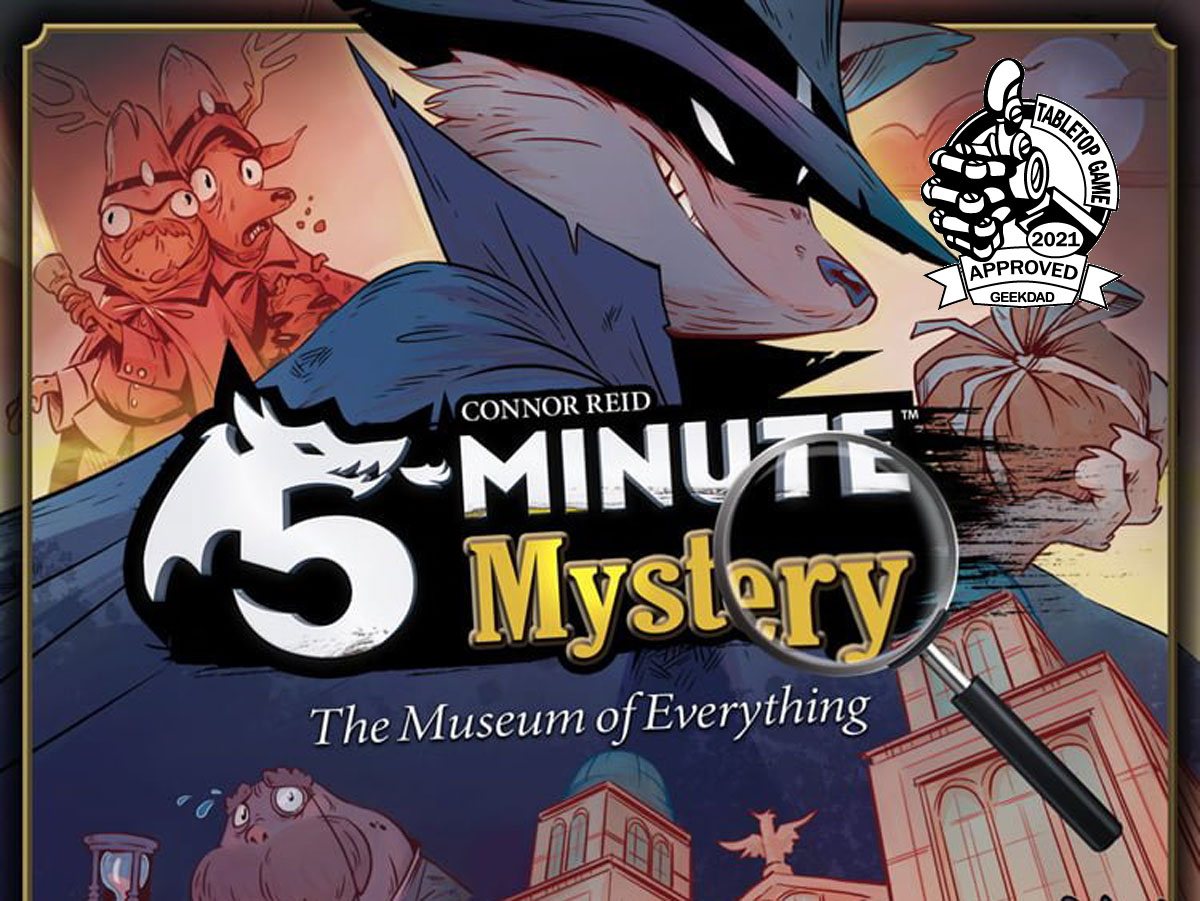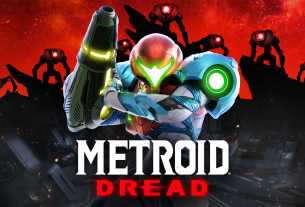The museum exhibit is set to open in 5 minutes, but somebody has stolen the MacGuffin? Work together to find the culprit before time runs out!
In Reaping the Rewards, I take a look at the finished product from a crowdfunding campaign. 5-Minute Mystery was originally funded on Kickstarter in December 2019, and shipped to backers at the end of 2020. This review is adapted from my Kickstarter Tabletop Alert to show the finished game.
What Is 5-Minute Mystery: The Museum of Everything?
5-Minute Mystery: The Museum of Everything is a real-time cooperative game from Wiggles 3D for 1 to 6 players, ages 8 and up, and takes about (you guessed it!) 5 minutes to play. It’s available now in retail stores for $26.95; the Kickstarter Mastermind edition (which includes a few extra components) is sold out at the publisher level, but you can check for available reserve stock through the website. The game involves observation and light deduction, and can be played by even younger kids; it’s also easy to adjust the difficulty level simply by changing the amount of time allowed to solve a case. They increased the player count from 4 (during the campaign) to 6, but really it’s mostly a factor of how many people can squeeze in and still see the picture. Individual cases can take from 3 to 9 minutes, though certainly 3- to 9-Minute Mystery isn’t quite as catchy as a title.
5-Minute Mystery was designed by Conor Reid and published by Wiggles3D, with illustrations by Cam Kendell and Alex Diochon.

5-Minute Mystery: The Museum of Everything Components
Here’s what comes in the retail edition of the game:
- Codex
- 6 Reference cards
- 16 Clues (4 each in 4 colors)
- 28 Suspect cards
- 28 Culprit tiles
- 16 Case File cards
- 32 Scene cards
The Mastermind Edition adds:
- 4 Red Herring clues
- 8 Suspect cards
- 8 Culprit tiles
- 8 Case File cards
- 8 Scene cards
The components all look great: the illustrations of the suspects and scenes are terrific, done in a cartoony style. But perhaps the most impressive component is the codex: a plastic cylinder with five rotating dials. Each dial has a particular symbol (square, triangle, circle, cross, star) in five different variations, along with one blank face. The prototype was 3D printed, but the finished codex is molded plastic with the symbols screen-printed onto the plastic. The dials spin easily and click into place, and it’s designed in such a way that each of the dials spins independently of the others. It’s lighter than it looks (particularly since the prototype was solid plastic and fairly heavy).
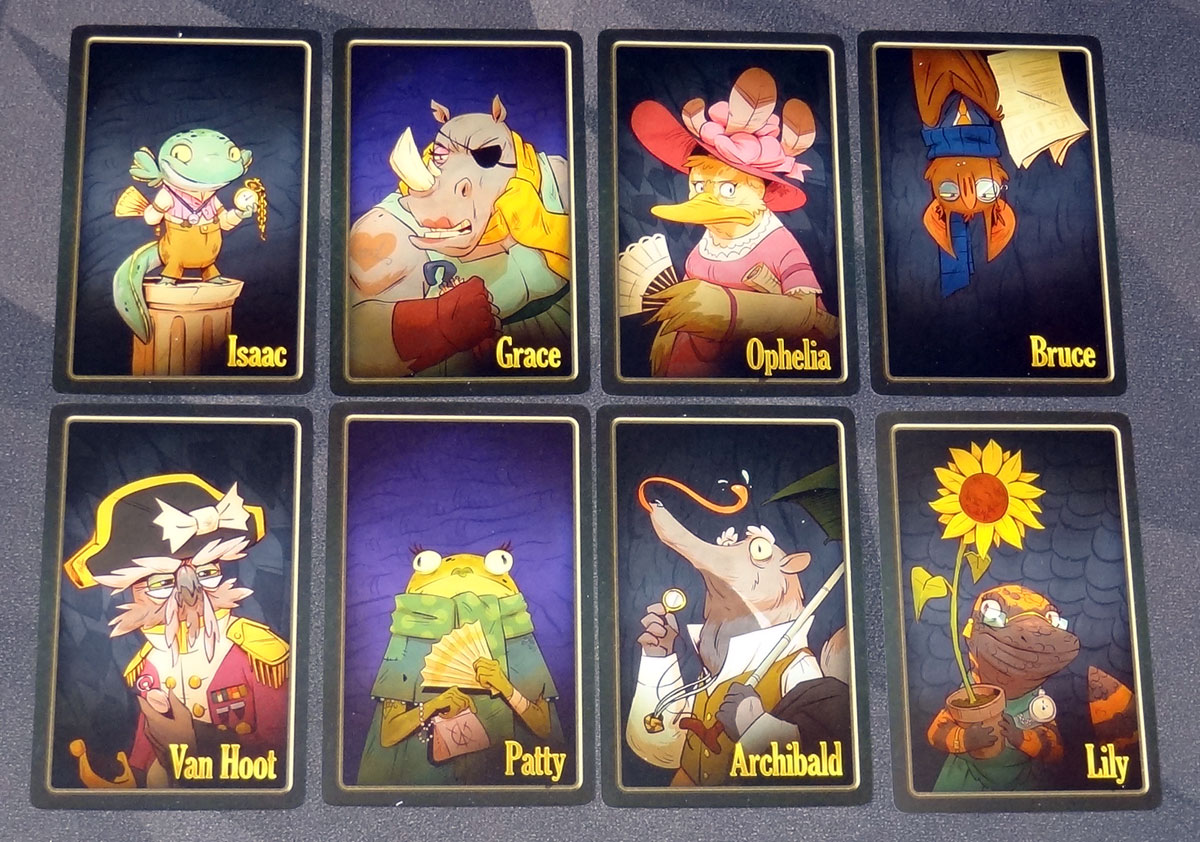
The suspects (represented both on the suspect cards and the culprit cards) look great: they’re all animals with various accessories, and all of them have guilty expressions on their faces. There were additional suspects added as stretch goals during the Kickstarter campaign, not including the extras in the Mastermind edition, so there are a lot of fun animal characters to enjoy. One nice thing that was added since the prototype is that the backgrounds of the suspect cards have a pattern indicating whether the suspect has scales, feathers, skin, or fur since that was sometimes confusing in the prototype.

The clue tiles are small square tiles that come in four different colors and depict the various accessories seen on the suspect portraits. The purple clues are the animal’s exterior type: scales, feathers, skin, or fur. Each one also has color bars on one edge, used for matching against the culprit tiles, which also have one of each color along the edge. My only complaint is that the backs and fronts of the clue tiles are oriented in a strange way—the bottom of the question mark always lines up with the color bars, even though the illustrations and text are rotated to fit around the culprit tiles. The Mastermind edition adds “Red Herring” clues, one for each color, that can be mixed in for added difficulty, since finding one does not give you any information at all.
The clue tiles don’t have special indicators for color, but the orientation of the clues show how they should be matched against the four sides of the culprit tile, so I think it shouldn’t be too much of a barrier for color-blind players.

The scene cards are oversized cards with illustrations of various rooms in the museum. The illustrations are lovely, and each one has the five symbols hidden somewhere on the drawing. It’s worth noting that there are multiple copies of each illustration with different symbols, so you won’t end up memorizing a scene card and remembering which symbol variation is on each one. The backs of the scene cards show the correct symbols.
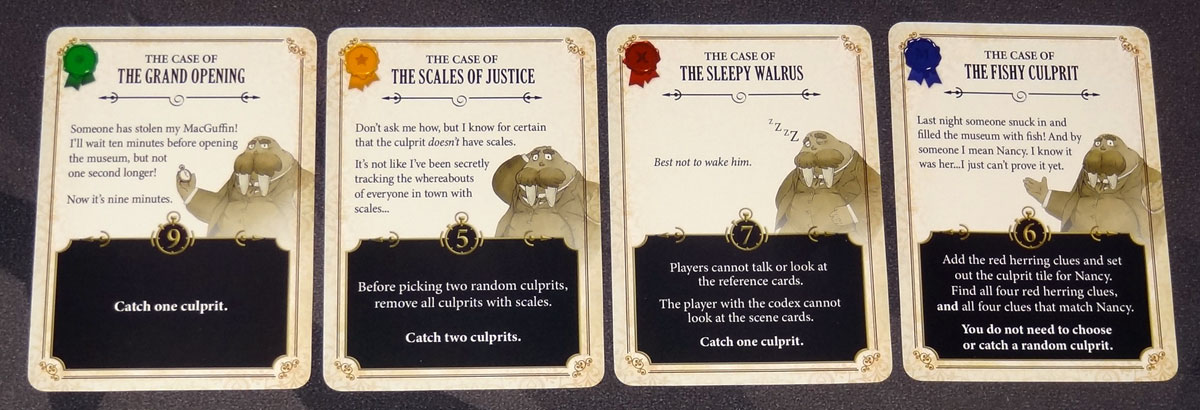
The case cards are probably the most significant change from the prototype: they’re regular-sized cards instead of the oversized cards, and each one has a bit of flavor text in the form of instructions from S. McBubbledy, the walrus curator of the Museum of Everything. The card also includes a case title, time limit, and special instructions for the case. There are three difficulty levels in the retail edition and a fourth “Mastermind” level in the Kickstarter edition.

The box insert is simple but functional: there are separate wells for the cards, codex, and tiles that hold everything in place without wasted space.
How to Play 5-Minute Mystery: The Museum of Everything
You can download a copy of the rulebook here.
The Goal
The goal of the game is to work together to catch the culprit before time runs out—though some of the case files modify the goal.
Setup
Choose a case card. (For advanced play, you can make a mix of 5 case cards and play through them in sequence.)
Shuffle the scene cards, and then place them in a stack face-up. (Be sure to check if the case file has special setup instructions.)
Shuffle the culprit tiles and randomly choose one, placing it in the center of the table face-down. Put the rest away without looking at them. Mix up the clue tiles and make four piles according to color. (Leave out the Red Herring tiles unless you want to increase the difficulty level.)
Distribute the suspect cards to all the players.
Reset the codex so that the blank faces are all facing up (between the arrows on the end pieces). Players will take turns operating the codex, so give it to a random starting player.
Start a 5-minute timer! (There’s a timer app, available for iOS and Android, that has some voice acting to introduce each case and announces each minute mark, with some background music.)

Gameplay
As soon as the timer starts, players reveal the first scene card and start looking for the five symbols, which the codex operator will select on the dials.
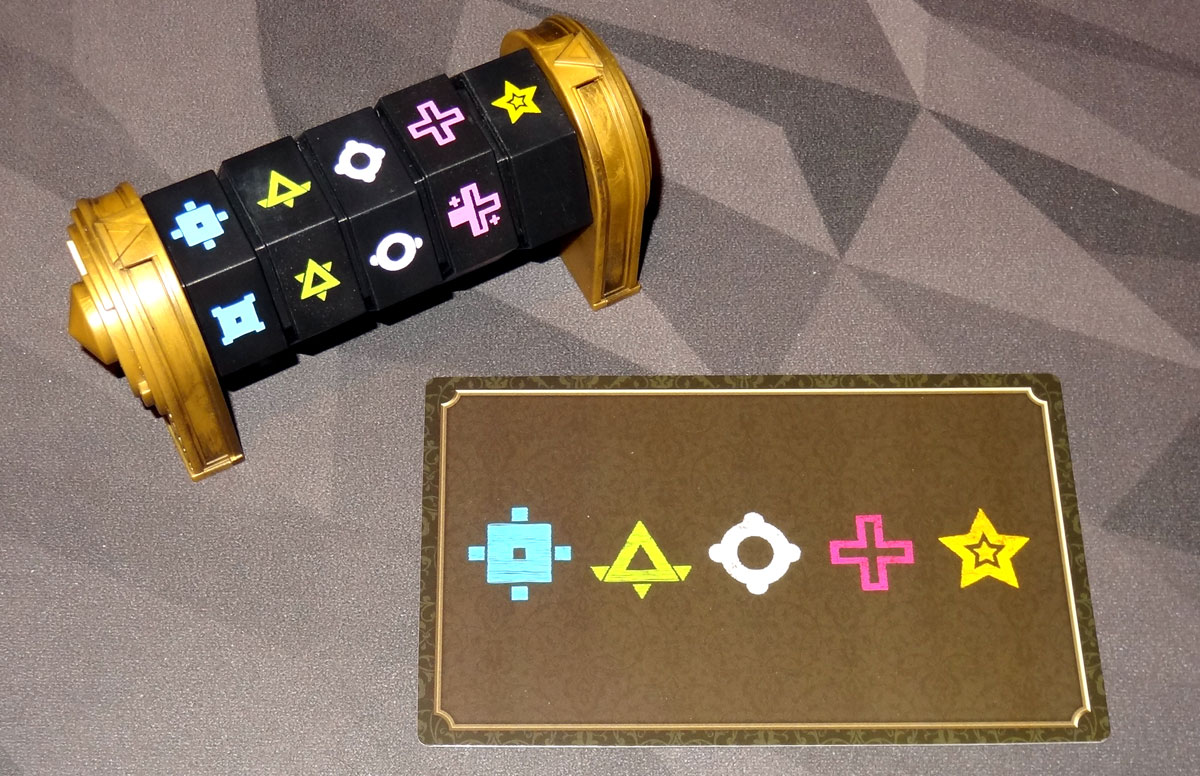
After all 5 symbols are dialed in, flip over the scene card and check if you’ve gotten everything correct. If so, you get a clue! If not, you just try a new scene.

If you successfully complete a scene, you draw any clue tile and reveal it. Match up the color bars against the culprit tile. If they match, then the culprit has the feature shown; otherwise, they don’t have it. In the photo above, the culprit has a scarf, but not a monocle (so you would set the monocle tile aside after checking). All players can discard suspect cards based on the information from the clues.
Flip to the next scene card (and pass the codex). You continue searching scenes and picking up clues, attempting to narrow it down to a single suspect.
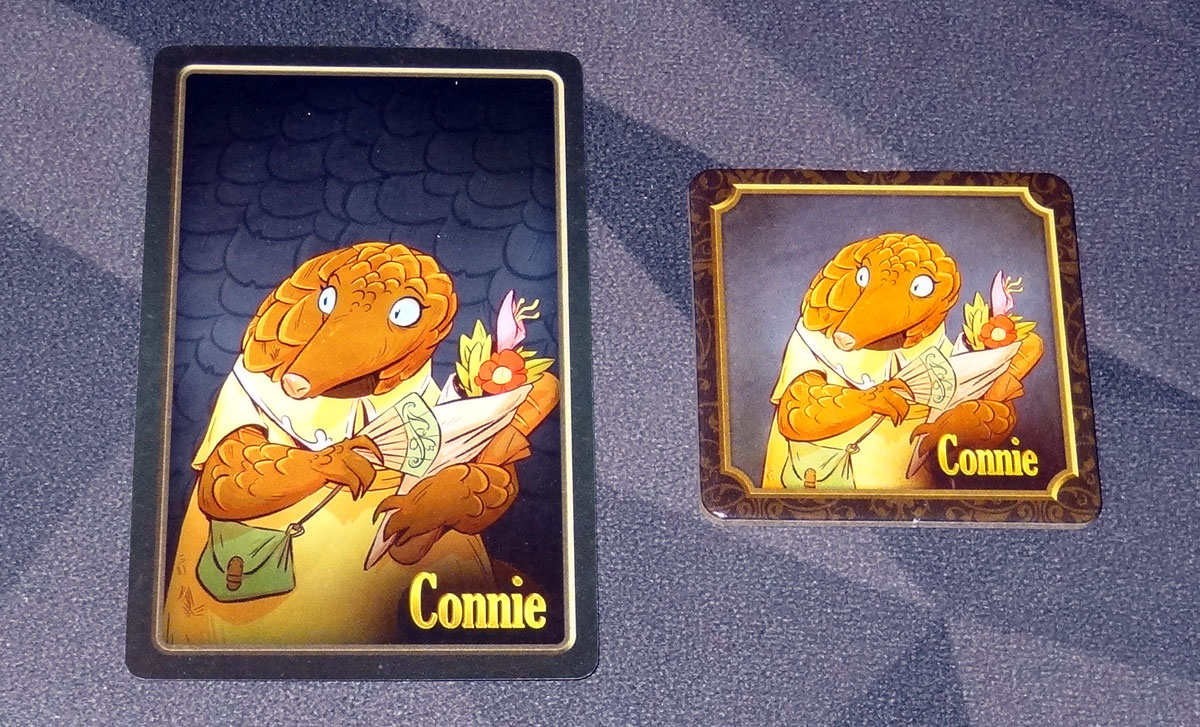
Game End
If you think you’ve figured out the culprit or you run out of time, then you make a guess. Reveal the culprit and check to see if it matches your guess. If it does, you win! If not, then you’ve arrested the wrong suspect and you lose.
Case Files
The case files provide different scenarios to play to gradually increase the difficulty. The introductory case file gives you 9 minutes, but other cases include catching two culprits simultaneously, and even trying to solve a case without talking!
Why You Should Play 5-Minute Mystery: The Museum of Everything
I’m a big fan of real-time games: I like the time pressure, the challenge of thinking and acting quickly, and the intensity of focus needed. But my kids and most of my gaming group don’t tend to like them—for the very same reasons. They’re too intense and stressful! In fact, whenever I mention that I have a real-time cooperative game to try out, I usually get a chorus of groans.
One exception has been 5-Minute Dungeon (the predecessor to 5-Minute Mystery). For whatever reason, they all loved the frantic card-flinging, the humor in the various cards you encounter, the silly voices on the timer app. When we play 5-Minute Dungeon, we often play several bosses in a row. So 5-Minute Mystery wasn’t a tough sell for them and they were happy to give it a try.
First, I’ll mention that despite the fact that they’re both real-time games from the same publisher, these are very different games. In fact, those are probably the only things they have in common in terms of gameplay. Where 5-Minute Dungeon involved a lot of shouting and slapping down cards and a flurry of activity, 5-Minute Mystery is a bit more subdued, because it’s more about observation than action. Everyone is staring at the scene card, pointing out symbols and relaying that information to the codex operator, who is spinning dials to match.
When a clue is obtained, picking a tile and matching it up to the culprit doesn’t take a lot of motion. I suppose there is a little bit of card-flinging as suspects are eliminated, but it’s not quite as urgent, because there’s nothing preventing you from continuing to the next scene card while somebody is still sorting through their suspect cards. Even though there’s still the same time pressure to solve the case, it feels a little calmer overall than 5-Minute Dungeon.
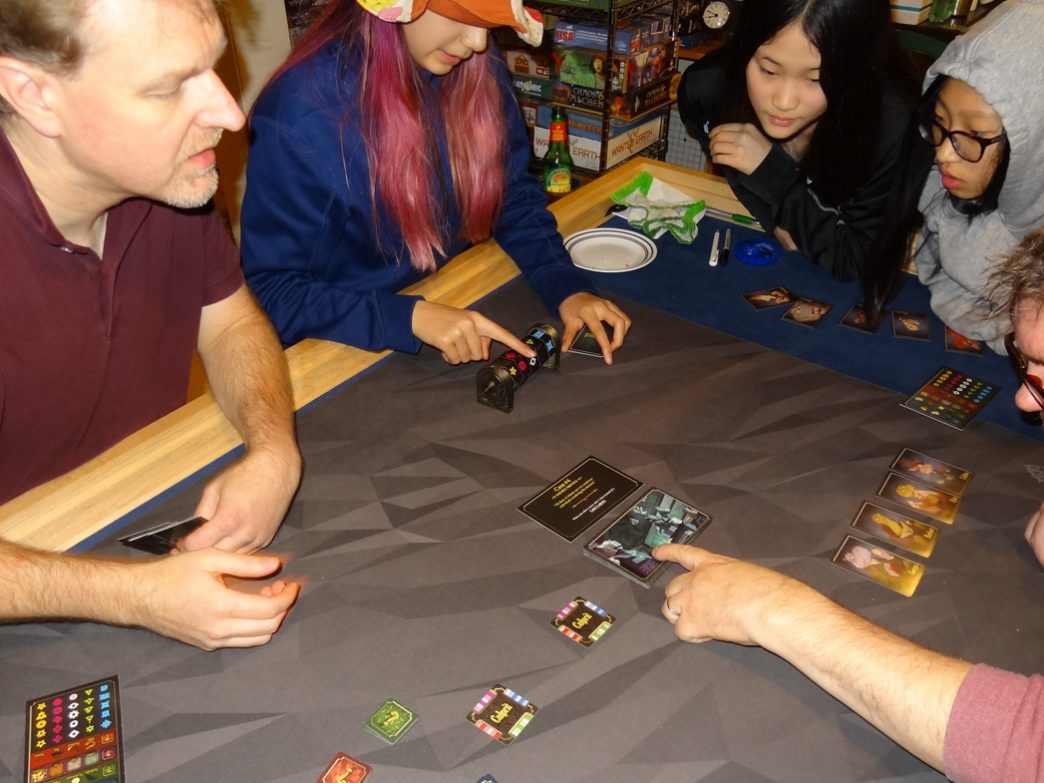
We’ve had a lot of fun with it. Hidden object games have been around for a long time, and I’ve played a lot of them—from the hidden pictures in Highlights Magazine to point-and-click computer games—and this has a similar feel, even though you’re only looking for symbols instead of objects. Some of them are easier to find than others; certainly, it helps to have a pair of sharp eyes, and we found that the kids were typically a bit faster than the adults at this part.
I really like the clues and culprits, too: it reminds me of games like Guess Who? or the more recent Dinosaur Tea Party, where you use some light deduction and observation to whittle a list of suspects down to one based on their various accessories and features. At the beginning, it usually doesn’t matter which clue you take because you just need to get started somewhere. But as you play, you might find that some clue colors will be more useful in narrowing down your remaining suspects: the dilemma there is whether to spend a few more seconds deciding on a clue, or just grab the nearest one and go for speed rather than deliberation.
The case files add some fun wrinkles to the game, and we’ve had fun making our way through the variations. The finished game ended up with 16 case files (and 8 more in the Mastermind edition), and there are some wacky scenarios that show up.
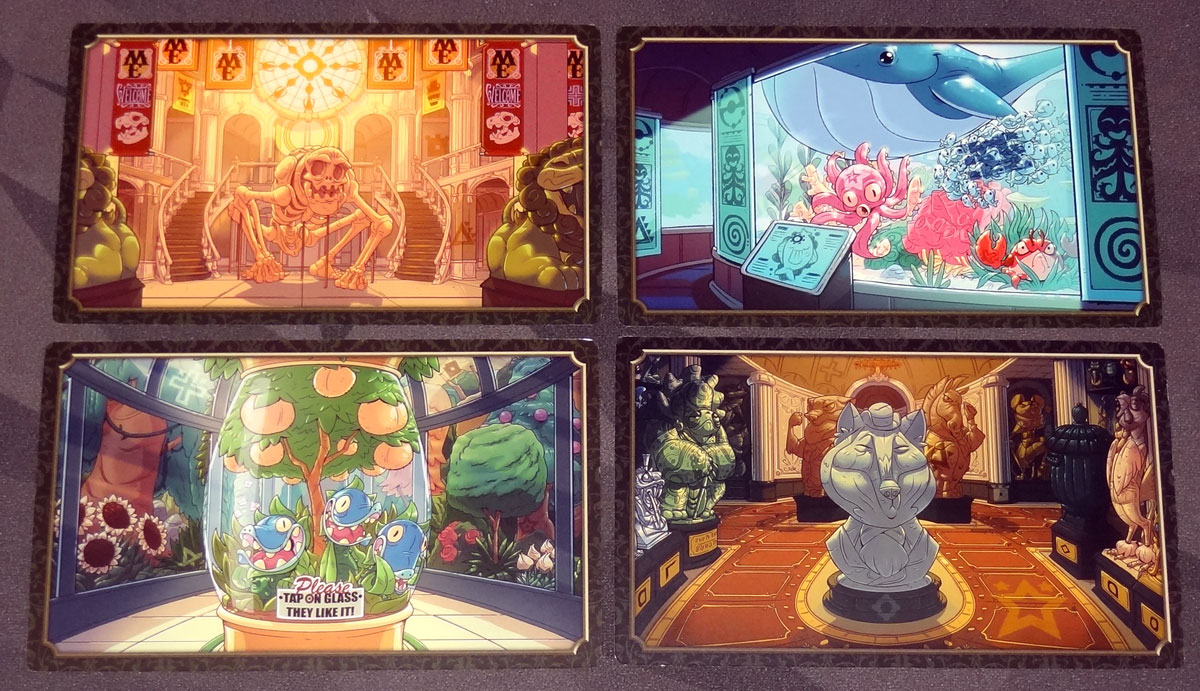
The finished copy arrived in late 2020 and I haven’t been hosting in-person game nights, so I haven’t been able to get my usual group together to play it—and it’s not necessarily one that would work well over video without some allowances for the fact that one person is in charge of moving everything around. (Though it may be possible to divvy up the work a little if people had multiple copies.) But it was definitely a hit when we played the prototype, and I’m excited to play it some more and work through the cases when the opportunity arises.
5-Minute Mystery is a fun mash-up of a hidden-object game and Guess Who? packed into just five intense minutes of sleuthing—that is, if you can stop after only one case.
Click here to see all our tabletop game reviews.
![]() To subscribe to GeekDad’s tabletop gaming coverage, please copy this link and add it to your RSS reader.
To subscribe to GeekDad’s tabletop gaming coverage, please copy this link and add it to your RSS reader.
Disclosure: GeekDad received a copy of this game for review purposes.
